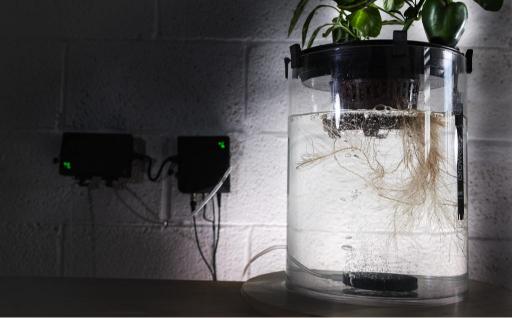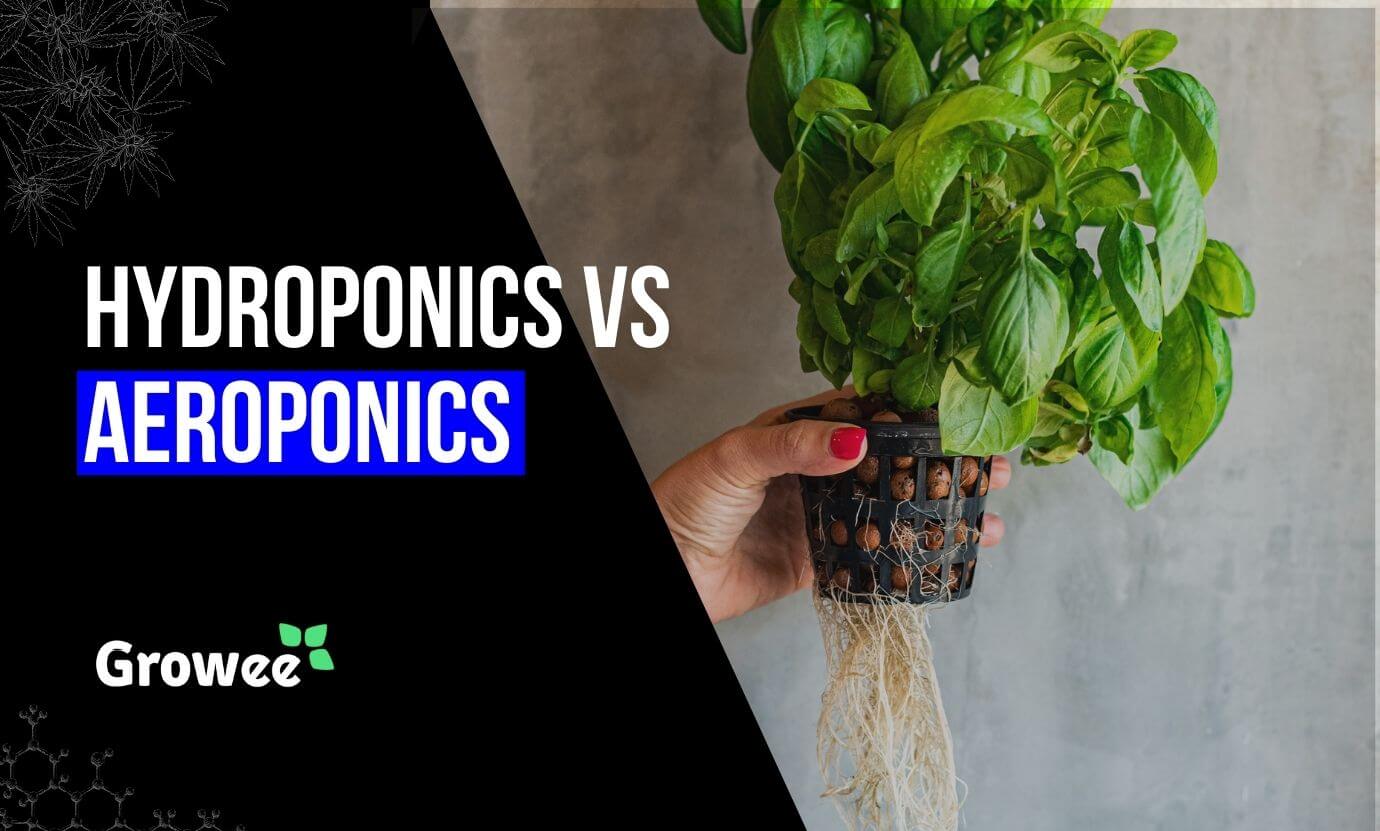If you are planning on growing your own legal cannabis at home, choosing the best growing medium for your purposes is very important. Today, we want to do an in-depth hydroponics vs aeroponics comparison to see which one is better suited for you and your needs.
In this hydroponic vs aeroponic comparison, we’ll determine what exactly both of these are, what makes them similar and different, and what both of their respective advantages when compared to each other are. By the end of this aeroponic vs hydroponic review, you’ll know everything you need to know about both growth methods to make an informed and accurate decision.
What is Hydroponics?
Hydroponics is a specific way of growing cannabis and other plants. This is a unique way of growing plants, as it does not involve soil, and is therefore known as a soilless growing method. Hydroponics involves the roots of the plants being immersed in a solution of water and nutrients which provide the plant with all of the nourishment it needs.
Plants are placed in an inert growing medium like clay pellet, coco coir, or rockwool, and the roots hang down into a carefully calculated nutrient solution.
As you’ll see below, there are different types of hydroponics systems, such as DWC, NFT, ebb and flow, and others, each of which is slightly different. There are various advantages to hydroponics, including greater water efficiency, precise nutrient control, the faster growth of plants, year-round growing, and space efficiency.
See How Growee Can Save You Time By Automating Your Plants Feeding
Water pH – Automated pH Up and Down Control
Nutrients Mixing – Automated Nutrient Dosing with Target EC / PPM Control.
Control From Anywhere – WiFi Connection and mobile App
What is Aeroponics?
Although aeroponics is similar to hydroponics, there are some subtle differences worth noting, as we will see further below. However, for now, the easiest way to explain it is by saying that whereas hydroponics involves the roots being suspended in a nutrient solution, with aeroponics, the roots are suspended in the air.
An aeroponic growing method involves the plants being suspended with the roots hanging down into a misting chamber. Here, a series of pumps and sprays regularly mist the plant roots with a nutrient rich solution to provide them with nourishment, as often as every ten minutes.
Aeroponics does also have some major pros, including being very efficient with water usage, being space efficient, reducing the risk of disease and pests, being very flexible and versatile, and allowing for fast plant growth combined with high yields.
While aeroponics boasts numerous advantages, it’s essential to acknowledge the potential risks associated with this innovative growing method. One primary concern is the system’s vulnerability to power outages or pump failures. In the absence of electricity or in case of pump malfunctions, the crucial misting process that nourishes the plant roots can come to a halt. This interruption can lead to the roots drying out and, ultimately, the demise of your plants.
Additionally, because the roots are suspended in the misting chamber, they are exposed and delicate. Any issues with the misting system, such as clogs or irregular spray patterns, can harm the roots and hinder nutrient absorption. Vigilance and regular maintenance are paramount in aeroponics to prevent potential setbacks.
Similarities Between Hydroponics and Aeroponics
When it comes to hydroponics vs aeroponics, there are some notable similarities between the two.
- They both allow for efficient space usage and are ideal for small areas.
- Both growing methods are very efficient as far as water usage is concerned.
- Both hydroponics and aeroponics provide a controlled growing environment.
- Neither of these growing methods involves the use of soil.
- Aeroponics and hydroponics both allow for year-round plant growth.
- Both growth methods tend to result in faster plant growth and higher yields compared to when plants are grown in soil.
- Because there is no soil, the risk of disease is also reduced.
Differences Between Hydroponics and Aeroponics
There are also some notable differences between hydroponics and aeroponics worth talking about.
- In hydroponics, the plant roots are suspended in water, but in aeroponics, they are suspended in the air.
- Aeroponic systems tend to use less water than hydroponic systems.
- With aeroponics, there is usually no growing medium, whereas with hydroponics an inert medium is used.
- Hydroponic systems are usually easier to set up and maintain than aeroponic systems.

Types of Hydroponic Systems
There are five main types of hydroponic systems that you need to know about.
1. Deep Water Culture (DWC)
Here, the roots of the plants are suspended in a nutrient solution, with the plants usually being supported by a floating platform. An air pump is then used to oxygenate the water and nutrient solution. This is one of the simplest and easiest hydroponics setups.
2. Nutrient Film Technology (NFT)
Instead of plant roots being totally submerged in water, here, a thin film of a nutrient rich solution flows over the roots of the plants, with the plants being held in small cups or pots. The nutrient solution flows through tubing or a sloped channel, and helps to feed the plants.
3. Ebb and Flow (Flood and Drain)
The defining feature of an ebb and flow system is that instead of plant roots being continuously submerged, here the nutrient solution floods into the chamber and feeds the plants, and then drains back out. The nutrient solution periodically floods and drains from the growing area.
4. Wick System
The wick system is very simple, and here you have a wick made of cotton or felt that hangs down into a reservoir of water and nutrients. This piece of fabric acts like a candle wick and pulls the nutrient solution up towards the plants.
5. Drip System
In a drip system, there is a series of tubes and pipes that continuously drip a predetermined amount of nutrient solution onto the roots of the plants.
Types of Aeroponics Systems
There are also several types of aeroponics systems, so let’s take a quick look at these as well.
1. Low-Pressure Aeroponics (LPA)
This type of aeroponics system involves the use of low pressure pumps that produce a fine mist nutrient solution that is sprayed onto plant roots. This is a great method to use for a high nutrient uptake.
2. High-Pressure Aeroponics (HPA)
With a high pressure aeroponics setup, the mist of the nutrient solution comes out under much more pressure than with the previous method, therefore creating much smaller droplets. This is designed to allow plant roots to absorb the nutrient solution much easier.
3. Ultrasonic Fog Aeroponics
This is one of the most interesting aeroponics setups, because there are special ultrasonic vibration systems that create a fine mist or fog of nutrient solution that coats the roots of the plants. This is a great way to enhance root development.
4. Nutrient Film Technique (NFT) Aeroponics
What you get with nutrient film technique aeroponics is a combination of aeroponics and hydroponics, a rather complicated setup that admittedly most people won’t choose.
5. Vertical Aeroponics
Vertical aeroponics involves either low pressure or high pressure aeroponics setups, but plants are grown in a vertical manner, or in other words stacked on top of each other, which is great in terms of space efficiency.
Cost of Hydroponics
Exactly how much hydroponics costs depends on a variety of factors, including the specific type of hydroponic setup you are going for. Generally speaking, you can expect to spend anywhere between $50 and $20,000, and of course, the size of your setup matters too. For the most part, you should be able to get away with spending around $1,000 for an average home setup. Find out how to increase your yield!
Cost of Aeroponics
Due to the pumps and added equipment needed to spray the plants with nutrients, an aeroponic system may cost a bit more to set up than a hydroponic system.
Although the price range is much the same in the grand scheme of things, a small aeroponic setup will cost more than a small hydroponic setup, especially the initial cost. You could easily spend $1,500 on an average home setup. However, something to keep in mind is that aeroponic systems are usually cheaper to maintain over the long run.
Which is Better?
When it comes to hydroponics vs aeroponics, particularly which one is better, this depends on your needs. If water and space efficiency are what you are going for, then aeroponics would be best, but if it’s a simpler overall setup with less monitoring that you want, then hydroponics is better.
Root Development for Cuttings
Many experienced growers consider aeroponics an ideal method for initiating new plant growth from cuttings or clones. This approach offers several advantages when it comes to nurturing robust root structures and optimizing time efficiency.
When starting a new grow from cuttings, aeroponics provides an environment conducive to rapid root development. The misting chamber delivers a consistent nutrient-rich solution to the exposed roots, stimulating their growth. This method is particularly effective in encouraging the formation of healthy and extensive root systems.
Once the young plants have established well-developed roots, they can be carefully transitioned into other growing mediums or hydroponic systems. This practice is highly regarded by many growers for its ability to enhance the initial root structure and save valuable time in the cultivation process.
By leveraging aeroponics in the early stages of plant growth, cultivators can set a solid foundation for their crops, leading to healthier and more vigorous plants as they progress through various growth phases.
FAQ
Is hydroponics better than aeroponics?
Hydroponics is easier to set up and maintain, but aeroponics has its advantages too.
Which is cheaper hydroponics or aeroponics?
Aeroponic setups are more expensive initially, but usually cheaper to maintain over the long run.
What is the difference between hydro aqua and aeroponics?
The biggest difference is that hydroponics involves submerging the plant roots in a nutrient solution, whereas aeroponics involves misting the roots.
What are the disadvantages of hydroponics and aeroponics?
Compared to growing plants in soil, both of these growth methods can be complicated, costly, and require more maintenance.



